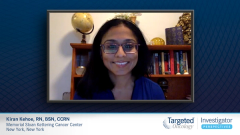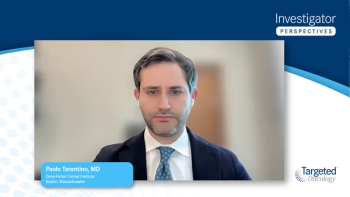
Design and Key Takeaways of the CLEAR Study in mRCC
Reactions to efficacy and safety data demonstrated by the CLEAR study of lenvatinib plus pembrolizumab as first-line treatment for metastatic renal cell carcinoma.
Episodes in this series

Chung-Han Lee, MD, PhD: The CLEAR study was a randomized phase 3 clinical trial looking at 3 arms. Patients were randomized with lenvatinib plus pembrolizumab, lenvatinib plus everolimus, or sunitinib. This trial was designed to look at and compare the efficacy outcomes of these 3 regimens. The study population included patients with treatment-naïve clear cell kidney cancer that had resisted measurable disease. The key efficacy end point that they looked at was progression-free survival with key secondary end points, including objective response rate and overall survival. This study was a positive clinical trial with the evaluation of over 1000 patients. It demonstrated that the combination of lenvatinib plus pembrolizumab showed improvements in progression-free survival of about 24 months’ median progression-free survival compared with 9 months for sunitinib. And it showed an objective response rate of 71% with a 16% CR [complete response] rate compared with sunitinib. This was found to be statistically significant, along with an improvement in overall survival. For overall survival, the follow-up on this study was short enough that the medians were not reached. But even at the data cutoff, they demonstrated that the combination of lenvatinib plus pembrolizumab had a hazard ratio of 0.61 with a significant P value of .005.
Kiran Kehoe, RN, BSN, CCRN: Safety outcomes from the CLEAR trial do indicate that almost all patients did develop some degree of adverse events. Specifically, with the lenvatinib-pembrolizumab arm, 99.7% of the patients did develop some degree of adverse events. When we talk about a grading system for adverse events, grade 1 to 2 adverse events are considered mild to moderate from the treatment regimen, and grade 3 or more are considered severe. Specifically, with lenvatinib-pembrolizumab, 82.4% of the patients did experience grade 3 or higher adverse events. The most common adverse event identified was diarrhea, and the secondary adverse event was hypertension.
For management of diarrhea, we assess patients and their frequency of bowel movements. It’s important to always get a baseline of how often they do have bowel movements, and then you set it as a comparison. Usually, 3 or more loose, watery stools above your baseline would be considered a grade 2. If it’s more frequent, then it’s grade 3 or higher. But in terms of management, with the lenvatinib-pembrolizumab, we do expect dose modifications with the lenvatinib specifically. In general, we start patients on lenvatinib 20 mg. We reduce the dosing or, if the diarrhea is quite severe, we hold the medication altogether and manage further. Those would be our interventions.
That being said, diarrhea can also occur from pembrolizumab, from the immunotherapy. Patients present with diarrhea, we also always obtain a stool sample to confirm that there’s no active infection going on. We would also prescribe Imodium once they were cleared for any active infection. But our goal is to achieve a dose of medication with the lenvatinib, so they have a good quality of life and are able to not have to use the bathroom and have bowel movements very often.
Another common adverse event that was identified was high blood pressure, or hypertension. This can be challenging when we start patients on this regimen. On lenvatinib-pembrolizumab specifically, we’ve seen that lenvatinib does increase blood pressures. And if patients already have a history of hypertension, we have to be very diligent in managing their blood pressure. One intervention that we start with when patients start this regimen is to have them obtain a blood pressure log and go over how to take their blood pressures every day and how to take them correctly. And then have that identify blood pressure perimeters, when we would ask the patients to call us if their blood pressures were over a certain number or if they were symptomatic. With the adverse events that are identified, we initially do face some challenges to adjust dosing. But once we can manage the adverse events and keep them at a dose that improves their quality of life, we find that does work. It just may take some time to get to that.
Transcript edited for clarity.









































